|
Model engines that were just being
released for production in the year this article was written are now 52 years old,
and would therefore now qualify as vintage engines in any modern model engine museum.
The article's author, Pete Chinn, probably did not even conceive of the possibility
while writing his piece in November 1959. He has some enviable model engines from
as far back as the Stagner 7.4 cu.in. V-4, circa 1909. At the time, the Wright Brothers
were developing engines not a lot larger than that for their full-size craft (well,
a tad bit larger). That makes model aircraft engines, as an entity, just about 100
years old. Amazing. Sure, there are a few out there older, but not many. The
November 1959 edition
of American Modeler had the first part of this article with more of Mr. Chinn's
model motors.
"Pete" Chinn concludes his fascinating report on the
Model Motor Museums
Next to the Brown, every collector of historic engines wants a Baby Cyclone. This,
the first of so many Atwood de-signs (others: early Phantom and Torpedo, Champion,
Glo-Devil, Triumph, Wasp, Shriek, Wen-Mac), was first marketed in 1935 and was subsequently
produced in three modified versions known as the Models D, E and F, from 1936 through
1939.
 Bruce Underwood, Columbus, Ohio, owns largest
collection, over 220 motors.
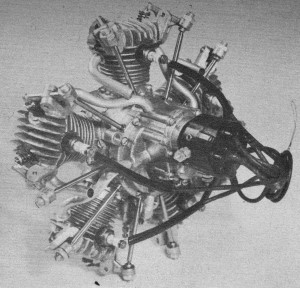
Most complicated production engine, .92 cu. in. Burgess M-5.
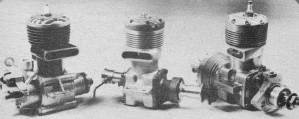
British G. S. Wizard, latest McCoy, supercharged Rowell (all 60's).

German .03 Star diesel, Cox Pee Wee, British Kalper .02 diesel.

Swiss Dyno .12 was first model "diesel."
Although large numbers of Baby Cyclones were built, they are now very difficult
to find, especially the pre-1937 models. Early Cyclones can be identified by their
plain unfinned heads and the very earliest models have a fixed timer, speed control
being by means of the needle-valve only. These early models sold for $15.75, complete
with coil and condenser, ready-mounted on a wood base carrying a gravity-feed fuel
tank. The .36 cu. in. Baby Cyclone (bore and stroke *" x 13/16") pioneered the use
of the shaft rotary valve in model aircraft motors. It also differs from the Brown
in a number of other respects. The cylinder, for example, is an iron casting with
shrunk-on duralumin cooling fins and is secured to the diecast crankcase by a base
flange and two screws.
Other popular engines of the mid-thirties. included Dan Bunch's .45 cu. in.
Gwin-Aero and Mighty-Midget, the G.H.Q. Loutrel and Forster Brothers' not-so-little
(nearly 1.0 cu. in.) Little Hercules. Both the Bunch engines and the G.H.Q. were
available as fully ma-chined sets of parts or as ready-assem-bled motors. The Gwin
and Mighty-Midget were somewhat similar to the Brown in general construction and
were among the first quantity-produced model engines to be fitted with piston rings.
The Forster and G.H.Q. were two of the very few model engines that survived to compete
in the post-war market.
From 1937 onwards, new engines began reaching the U.S. market in increasing numbers.
A young model builder named Irwin Ohlsson began selling a new .55 motor with radial
mounting re-placing the usual beam mount lugs and which, instead of having bypass
and intake passages brazed on, or integrally cast, used a two-piece diecast manifold
clamped around a plain machined cylinder. This, the ancestor of the famed Ohlsson &
Rice range, and later known as the Gold Seal model, appeared, for 1938, with combined
beam and radial mounting lugs, a feature common to every O&R engine down to
the present day. All the Ohlsson engines, incidentally, were actually made by the
Rice Mfg. Company of San Gabriel, Calif., who also supplied the parts from the James
60 motor of the same era.
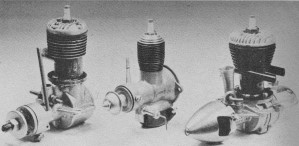 From the 1940's - Vivell 35, Arden 099, Phantom
P.30.
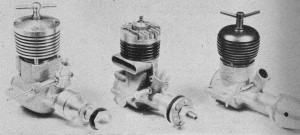
Winners of last 3 FAI free flight titles - British Oliver Tiger (1955), Japanese
O. S. Max 15 (1956), East German Schlosser 2.5 (1958).
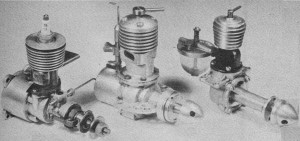
British H-P 24 spark ignition, ball-bearing B.M.P. 21 diesel and Allbon 17 diesel.
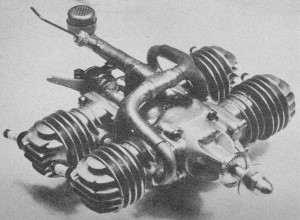
Elf-Four had .39 cu. in. total displacement, 9 oz. weight (a twin and 6 cylinder
were also made).
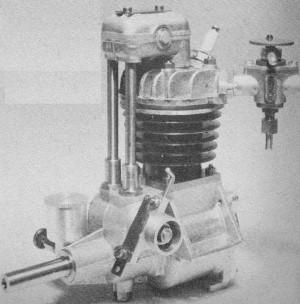
British Jensen 60 4-cycle of late 1940's.
Articles About Engines and Motors for Model Airplanes, Boats, and Cars:
|